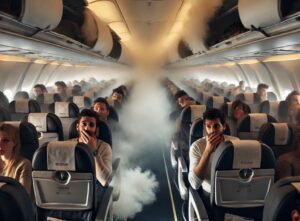
Smokes in the aircraft cabin (an AI illustration only)
What does smoke with the smell of fire in an airliner cabin mean?
Smoke with the smell of fire in an aircraft cabin could indicate a potential fire, which is a rare but serious situation. While smoke or fumes in the cockpit or cabin are uncommon, they can have dire consequences.
For instance, on September 2, 1998, Swissair Flight 111, an MD-11, experienced smoke in the cockpit, which escalated into a fire, leading to a catastrophic crash.
The final transmission was a chilling “Mayday, Mayday, Mayday!” before all communication were lost. Tragically, all 229 people on board perished.
Similarly, in 1980, a fire in the rear cargo compartment of a Lockheed L-1011 TriStar led to the deaths of all 301 passengers and crew after a delayed evacuation upon returning to Riyadh.
Such incidents highlight the importance of fire detection, suppression systems, and emergency procedures to ensure safety for all the crew and passengers on board.
Aviation safety studies show that once a fire starts, the aircraft can become uncontrollable within 7 to 35 minutes, with an average of about 20 minutes. This means swift action by pilots to land is crucial.
The likely sources of smoke in the cabin could include electrical equipment failures, short circuits in wiring, overheating of equipment, leakage of hot air from pneumatic ducts, hydraulic fluid spilling onto hot surfaces or the overheating of ovens in the galley.
Most recently, on October 3, 2024, a Firefly flight from Kuala Lumpur to Penang was forced to return to Subang Airport when smoke filled the cabin.
The Civil Aviation Authority of Malaysia (CAAM) CEO, Datuk Captain Norazman Mahmud reported that the cause was an overheated air-conditioning system due to an extraction fan failure.
Fortunately, there was no visible fire, and the aircraft landed safely within 20 minutes. No injuries were reported.
Pilots and cabin crew are trained to manage smoke and fume events by donning oxygen masks, locating the source, and diverting the flight if necessary.
Airlines are also required to report such incidents, and aviation authorities would investigate to ensure safety before the aircraft is cleared to fly again.
Smoke or toxic fumes can cause serious health risks, but in this Firefly case, it appears that all the passengers were safely evacuated without further incident after landing.
A passenger, Harrell Erik Wong, recorded a video showing smoke filling the cabin and shared his experience in FaceBook. View his video here – https://www.facebook.com/1014415869/videos/528528700126138/
View another latest video on plane catching fire while landing here https://youtu.be/GgvnYM3lOn0